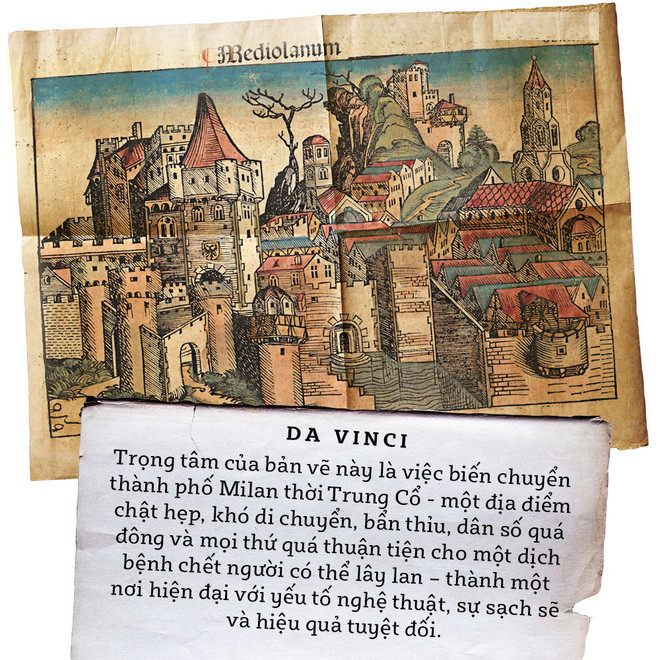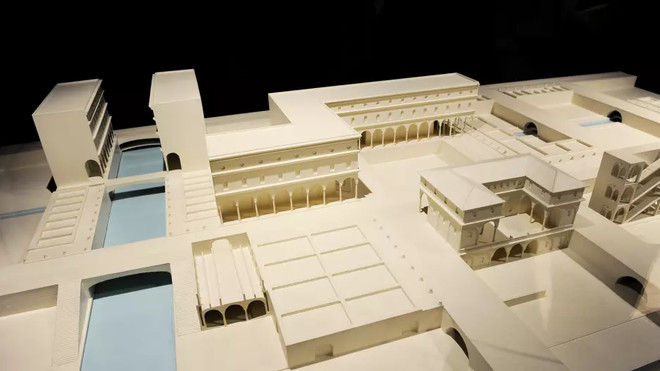Leonardo da Vinci's urban planning idea 521 years ago
Leonardo da Vinci had a vision for half a millennium: the city he envisioned seemed perfectly planned.
Leonardo da Vinci lived through the plague that ravaged Milan in 1484-1485. This deadly disease took 50,000 lives - one third of Milan's population at that time. He himself was unaffected, but it was this catastrophe that made da Vinci begin to draw a safer, cleaner, future city. The drawing was completed between 1487 and 1490.
The focus of this drawing is the transformation of the medieval city of Milan - a narrow, hard-to-move, dirty place, overcrowded population and everything too convenient for a deadly epidemic to spread. - into a modern place with artistic elements, cleanliness and absolute efficiency.

To achieve these goals, da Vinci applied two special systems into this future city, two systems that were supposed to be his own special imprints:
- A network of canals can both facilitate convenient trade but also clean water.
- The city is divided into three floors, 3 sections with 3 different purposes.

This is an idea built from the roots, not a city improvement plan. Basically, there must be a city on a big river so that this idea can work, or it will have to "rebuild" a whole city. Therefore, it is not surprising that people ignore this idea.
That plan doesn't work in that difficult time, but humanity now needs something like that, especially as the population is growing and we need an appropriate infrastructure system. Applying this plan also gives us another opportunity: called a person ahead of time.
From the pandemic to the problem
By dividing the city into 3 floors, da Vinci aims to clearly divide the travel and the area used to live. That was the time in 1487 when da Vinci came up with this idea, so it could be considered as the first attempt to plan the living area of human history. Until after the Industrial Revolution, this planning proved effective.

Da Vinci drew a separate area for cars and horses, which could be considered a special area for trade. When the second area will be reserved for residents. The third area will be the system of canals in the city, directly connected to the basement of the houses, convenient for transporting goods.
Imagine that the 3rd floor from above will be a living area; the second floor will be a place for cars, motorbikes, bicycles and pedestrians; 1st floor will be a system dedicated to cargo trucks, can take goods to each apartment or move from one warehouse to another.
With three floors serving these three goals, da Vinci envisioned a city operating in a different way. Roads are narrow, the most congested is when the peak of the epidemic is now more open, making an extremely important part in the ability to control disease in the city.

At the time, the life-threatening death toll of survivors made Leonardo da Vinci think of a way to cope with the upcoming similar disasters. In this 21st century, we have to deal with a similar danger, which is climate change.
Coastal areas are severely affected, there are residential areas disappearing. But a residential area itself faces the problem of certain climate change will have a large part in improving infrastructure to overcome difficulties.
A region, such as a city, which has its own economy, with a concentrated population nature of the local area, will be able to lead the race to reduce emissions and combat climate change.
Although Da Vinci draws the perspective of a three-story, best-standing city, with its current infrastructure, one should maintain planning in a horizontal direction. We will not divide the area according to the size or purpose of the buildings anymore, but will divide the area according to the type of vehicle that will be used within the area.

The downtown areas will have less traffic, a trend that has begun to appear in many major cities. The area around the city center will be the only place to run an automatic tram - automatic cars, automatic buses, and automatic freight cars. Contrary to what da Vinci draws is a canal system to transport goods, instead it will be a network of drones flying in the air for delivery.
All of these things have been drawn from Leonardo da Vinci's vision: a city that operates in a different way, a breath-taking future, easy to live with roads, clear transportation systems. and effective.

From carriage to self-driving car
Urban planners are trying to sell people in downtown areas without cars, with only people living, minimizing traffic congestion and ultimately improving the quality of life. There is a benefit that few people realize, which is to completely separate pedestrians from automated vehicles on the road.
Increasingly, people are worried about the quality of these autonomous vehicles, is it safe enough to "live" with people? Separating people and cars automatically into two different areas, the problem was suddenly solved smoothly.

Besides, there is one more problem: cities are designed for vehicles to go and park, not to go - stop picking up passengers - go on. Roads cannot turn into an "airport" of automated vehicles.
That's the old da Vinci thought: a complete separation of means and people. The best way to avoid traffic accidents is to avoid each other's faces. But instead, we need to redesign the transportation system, to connect lines with different types of vehicles harmoniously.
Redesigning the city and finding a new direction to move within the city, in the face of great danger called climate change, will be an extremely difficult challenge. Fortunately, we had a visionary predecessor who came up with a very feasible system. We can "borrow" some ideas from the great inventor Leonardo da Vinci.
- Hair fibers are expected to make history after 500 years Leonardo da Vinci died
- The solution helps Barcelona become the world's most quality transport city
- Scientists want to rebuild Leonardo da Vinci's genome
- 4 giant 'treasures' of Leonardo Da Vinci: The solution after 500 hundred years
- Leonardo da Vinci and secrets not everyone knows
- After 500 years, MIT proved that the bridge design of Leonardo Da Vinci is extremely reasonable
- Find out the descendant of the life of Leonardo da Vinci
- Discover the secret talent of the great Leonardo da Vinci
- Street art: The idea of interesting recycling of trash
- Singapore plans to become the first
- Effort to save Leonardo Da Vinci's self-portrait
- Memo book of Leonardo Da Vinci
 'Fine laughs' - Scary and painful torture in ancient times
'Fine laughs' - Scary and painful torture in ancient times The sequence of numbers 142857 of the Egyptian pyramids is known as the strangest number in the world - Why?
The sequence of numbers 142857 of the Egyptian pyramids is known as the strangest number in the world - Why? History of the iron
History of the iron What is alum?
What is alum?